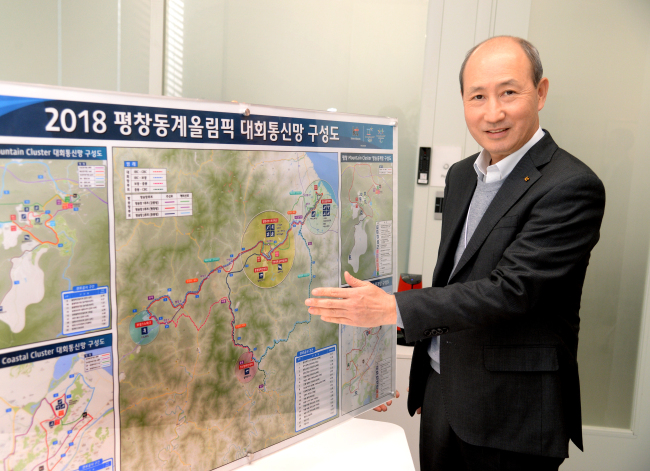[Herald Interview] Ushering in a 5G world
South Korean telecom giant KT to set new standards for telecommunications of Olympics, CEO says
By Song Su-hyunPublished : Nov. 24, 2017 - 16:47
Oh Seong-mok, president of KT’s network business, says one of his most unforgettable memories is of when he was with a group of engineers from mobile chipset makers and KT officials, standing on a ski jump built for the upcoming PyeongChang Winter Olympics.
The group had been mired in an endless debate over what would be the best specifications for the “5G Olympics” even after 10 months of heated overnight discussions via conference calls.
With no resolution in sight, they took a trip to the ski jump, one of the most challenging venues to implement the fifth-generation wireless service, hoping it would give them some ideas.
The group had been mired in an endless debate over what would be the best specifications for the “5G Olympics” even after 10 months of heated overnight discussions via conference calls.
With no resolution in sight, they took a trip to the ski jump, one of the most challenging venues to implement the fifth-generation wireless service, hoping it would give them some ideas.

It seems the trip provided enough inspiration. With the games three months away, Oh is confident they will be ready.
“Creating a new set of technological specifications is quite different from developing a single particular technology or a hardware product,” Oh said in an interview with The Korea Herald on Nov. 14 in his office at the KT headquarters in central Seoul.
“KT is arguably the first among Korean businesses in taking the lead in setting new global standards for a new era of network through this opportunity of being an official telecommunications partner for the Olympics,” he said.
One lesson the KT president says he has learned is that Korea can be good not only at manufacturing and developing things, but also at creating new ecosystems.
In order to showcase a 5G Olympics next year in PyeongChang, the Korean telecom giant is moving forward the commercialization of the next-generation network. And it is pressing industry players, including other mobile carriers, mobile chipmakers and handset makers, to speed up development of their own products and systems to be technologically compatible with the new network.
“Starting with the Olympic showcase, we will expand testing pilot services to other parts of the country, including the Pangyo Zero City (which is also earmarked to be the country’s first self-driving city),” he said. “The 5G services and network stations set for the Olympics won’t be used one time just for the event. The relevant equipment and specifications will be available for other uses after the games, serving as leading cases until international 5G standards are officially set.”
KT aims to commercialize 5G telecom services in the latter half of 2019, when consumers would expect to see iPhone 12 smartphones.
Oh highlighted that what KT was doing wouldn’t have been possible without cooperation from other companies and industries.
“KT’s efforts are made in the name of our country,” he said. “If KT is leading the 5G world, Korea is leading it, too. I remember when nobody thought this would be possible by the time of the PyeongChang Olympics when we visited Docomo in 2015 to learn their 5G progress for the 2020 Tokyo Olympics. Now the Japanese telecom industry is pretty embarrassed by our achievements so far.”
Oh spent most of his work hours for the last two years in PyeongChang, building the advanced network system in the mountainous region from scratch.
“We laid fiber optic cables for about 13,000 kilometers and used the 28Ghz band for the first time,” Oh said. “Thorough examination was conducted to study the traits of the frequency band and to test the speed for the actual games.”
Since KT Chairman Hwang Chang-gyu first mentioned the 5G Olympics at the Mobile World Congress in 2015, the company made all-out efforts to realize it.
“We started from nothing, and it was a challenge, but we are setting new standards for the global telecom industry,” Oh said.
KT has so far unveiled threepilot services for the Olympics: Sync View, 360-degree Live VR and Omni-View.
Sync View will use live streaming to show sports from the athletes’ point of view, allowing viewers to feel part of the action.
The 360-degree Live VR service is based on live virtual reality technology and will enable viewers to experience the games in a virtual reality environment.
Omni View, a live streaming service of selected multi-angle views, will provide biometric data of players on the screen and will allow viewers to choose the angle they want to view from.
KT is also preparing for onstage holographic performances at a special booth to be set up by the Ministry of Science and ICT.
KT has been working together with the ministry, PyeongChang Organizing Committee, and global companies including Samsung Electronics, Nokia, Ericsson and Intel to provide those services.
Oh said these 5G services will change the way the games are watched, Oh added.
“It is very difficult to apply new technologies to the Olympic Games, because they might disturb players,” he said. “We went through a hard time of introducing our technologies to the IOC and persuading them to approve them.”
For example, KT has been talking with the committee to allow attaching tiny cameras and Internet of Things devices to athletes, which are connected to the 5G network and will keep track of every single moment of players during games and broadcast it to viewers.
“Our 5G technologies will make unpopular games such as bobsleighing popular by exciting viewers,” Oh said. “The way of streaming the Olympics and viewing the games will be totally changed.”
By Song Su-hyun (song@heraldcorp.com)











![[Today’s K-pop] BTS pop-up event to come to Seoul](http://res.heraldm.com/phpwas/restmb_idxmake.php?idx=644&simg=/content/image/2024/04/17/20240417050734_0.jpg&u=)




![[KH Explains] Hyundai's full hybrid edge to pay off amid slow transition to pure EVs](http://res.heraldm.com/phpwas/restmb_idxmake.php?idx=652&simg=/content/image/2024/04/18/20240418050645_0.jpg&u=20240418181020)

![[Today’s K-pop] Zico drops snippet of collaboration with Jennie](http://res.heraldm.com/phpwas/restmb_idxmake.php?idx=642&simg=/content/image/2024/04/18/20240418050702_0.jpg&u=)